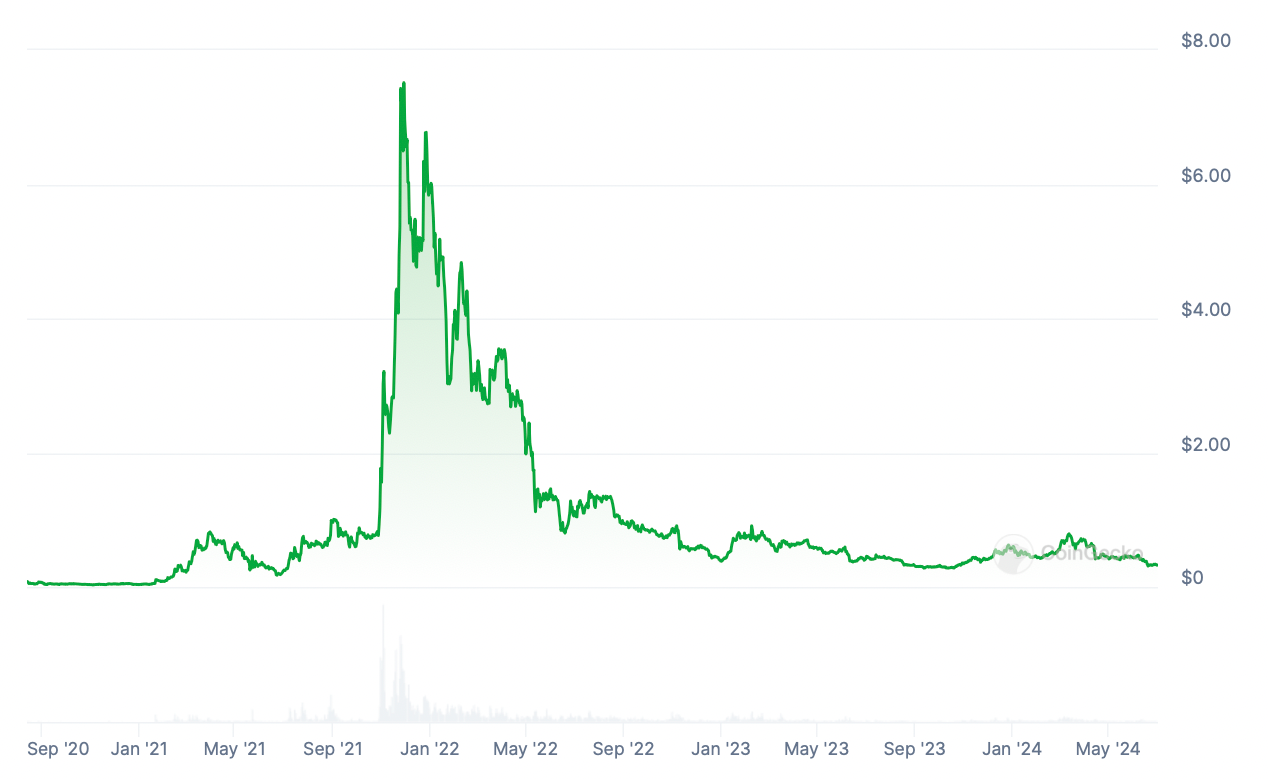Exploring play-to-earn (P2E) crypto games
Play-to-earn (P2E) games turn conventional gaming economics on its head. Instead of paying for the playtime, users earn rewards — actual crypto — by playing. This field is still nascent but growing by leaps and bounds. Here is the lowdown on P2E in 2024.
What are P2E games?
Until recently, video game players could not monetize their accomplishments or exchange in-game items for real-world money. P2E games fuse blockchain technology and non-fungible tokens (NFTs), combining traditional gaming conventions with crypto economics.
Characters, items, and other game assets exist as NFTs, unique blockchain-based collectibles. They are versatile, with in-game value and open-market utility — P2E NFTs are bought and sold like any other NFTs.
In 2021, the total value locked in P2E games dashed past $3 billion — a giant leap from $260 million at the start of the year. Two years later, this market reached a valuation of $104 billion, with projections of $174.47 billion by 2031.
As of June 28, 2024, the top three P2E tokens by market cap are FLOKI ($1.6 million), NOT ($1.5 million), and AXS (just under $1 million).

How P2E works
These games are fundamentally different from video games of the past, like World of Warcraft or Minecraft. P2E models stand out due to the following essential components.
- NFTs representing in-game assets. Characters, equipment, land, and other key gaming assets exist as NFTs. Their blockchain-based nature provides transparency of ownership and verification. Players can trade these NTFs for crypto or native tokens via in-game marketplaces, leading to the rise of robust economies with active trading within P2E environments.
- Tokens for gameplay. P2E games reward players for specific actions, from fighting enemies to completing quests to selling in-game items on specific markets.
- Native tokens. Players need native gaming tokens to progress in games, but these cryptocurrencies also have inherent value on exchanges. Native crypto of popular games may appreciate rapidly.
- Upfront costs. Typically, users must spend a certain amount of money or time earning a starter character or NFT.
- Competitive focus. P2E games reward players for skill. Tournaments and competitive rankings are fixtures, with prize pools usually denominated in NFTs or native tokens.
- Share in revenue and governance. Holders of P2E tokens typically have a say in the game governance and a share of the revenues. This way, incentives are aligned between players and developers.

How play-to-earn advances gaming
The rise of P2E worlds marks a dramatic shift that may transform the face of gaming for multiple reasons. Existing on the blockchain, these games offer persistent worlds that may evolve over decades, growing into complex economies focused on the player.
P2E advocates emphasize the benefits over conventional free-to-play games and the open-ended nature of digital economies formed around these products. Users gain a supreme sense of ownership.
- Player-owned economies. P2E games have a player-first orientation, giving users more control over their experience than those owned by corporations focused on maximizing revenues. Asset value rises proportionally to demand, incentivizing users to play early.
- True digital ownership. NFTs ensure true ownership of scarce in-game assets, as they are verified on the blockchain. Furthermore, their use makes digital ownership possible for all players, not only wealthy gamers. Accessibility sets P2E assets apart from skins and items in traditional games.
- Monetizing playtime. In P2E virtual worlds, gameplay effort pays off — literally. Gamers may earn actual rewards and potentially even a livelihood in developing nations. This dimension of value is absent from conventional gaming.
- Mutual benefits. Creators of P2E games benefit from players' participation, while players earn crypto rewards, monetizing their time and effort spent in games. This forms a robust symbiosis where the most engaged communities forge ahead. Thus, P2E powers innovative tokenomics models connecting gamers, developers, and the community.

Key concerns about P2E mechanics
On the downside, skeptics warn that excessive monetization and speculation will eclipse gameplay. They say P2E will turn gaming into grinding for rewards, diminishing the entertainment value and making it feel like a job.
Furthermore, rewards in some games are slanted toward early adopters and wealthy investor gamers, while other players struggle to profit. The economies must also be carefully crafted to remain sustainable, ensuring the rewards and costs are in balance.
Finally, blockchain technology brings its own set of challenges, including the need for regulatory clarity and education. Mainstream gamers must learn about the workings of the digital economy, including NFTs and tokenomics.
Examples of P2E games
Popular P2E games reflect the appeal of ownership and creative monetization, which define this gaming frontier. However, the appreciation of tokens and NFTs may hinder accessibility.
Axie Infinity
Inspired by Pokemon and Tamagotchi, this game was launched in 2018. It rewards players in SLP tokens — Smooth Love Potions. These are earned for playtime and daily quests. Players must collect, breed, raise, and battle peculiar creatures (Axie NFTs).
SLPs are versatile and valuable. Holders can use them to breed new Axies or trade in a robust marketplace. The most in-demand NFTs may sell for several thousand dollars. However, players must also buy three starter Axies — or borrow them via a scholarship, forfeiting a portion of future earnings — to start playing the game.

The Sandbox
This game provides a multifaceted metaverse experience built around voxel NFTs. Players acquire virtual land and assets to drive passive income by charging others to use them. It is a world where voxel experiences are built, owned, and monetized.
Additional mini P2E games provide multiple opportunities to earn native SAND tokens. Participants also receive SAND for crafting items. The tokens have exchange value and various use cases, such as purchasing new assets, names, avatars, land, etc.

Star Atlas
This online multiplayer blockbuster is set in a space-themed metaverse. Its P2E mechanics let players reap rewards for contributions and achievements. They explore this virtual world, engaging in space battles, mining resources, forging alliances, and trading assets.
The native token, ATLAS, has several use cases within the game, including trading and purchasing items, upgrading ships, and supporting the Star Atlas economy. It works alongside a secondary – governance — token, Star Atlas DAO (POLICE).
Looking ahead
Play-to-earn models turn gaming into a revenue-generating activity, rewarding playtime with assets having inherent value within and beyond in-game economies. One of the hottest frontiers in online gaming, P2E, is where crypto, NFTs, and DeFi converge. Despite growing pains and entry barriers, it represents the industry's future direction, with meteoric growth projected to last.



